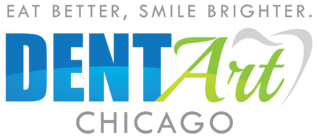Braces
Having crooked teeth can make you feel self-conscious about your smile and cause oral health issues such as tooth decay and gum disease. Braces are a proven method of straightening misaligned teeth and making your oral health easier to maintain. So why should you choose braces?

Improve Your Appearance
AND YOUR HEALTH
Boosted Self-Esteem
Achieving a straight, symmetrical smile with braces encourages a more positive self-image and greater confidence.
Versatile Treatment
Treatment with braces is easily customizable to a variety of issues, from slightly crooked teeth to severe misalignment.
A Balanced Bite
When your teeth are misaligned, it can result in tooth wear, temporomandibular joint (TMJ) disorder, and other issues. Braces can restore comfort and benefit your long-term oral health.
Let’s break it down and see how braces work...
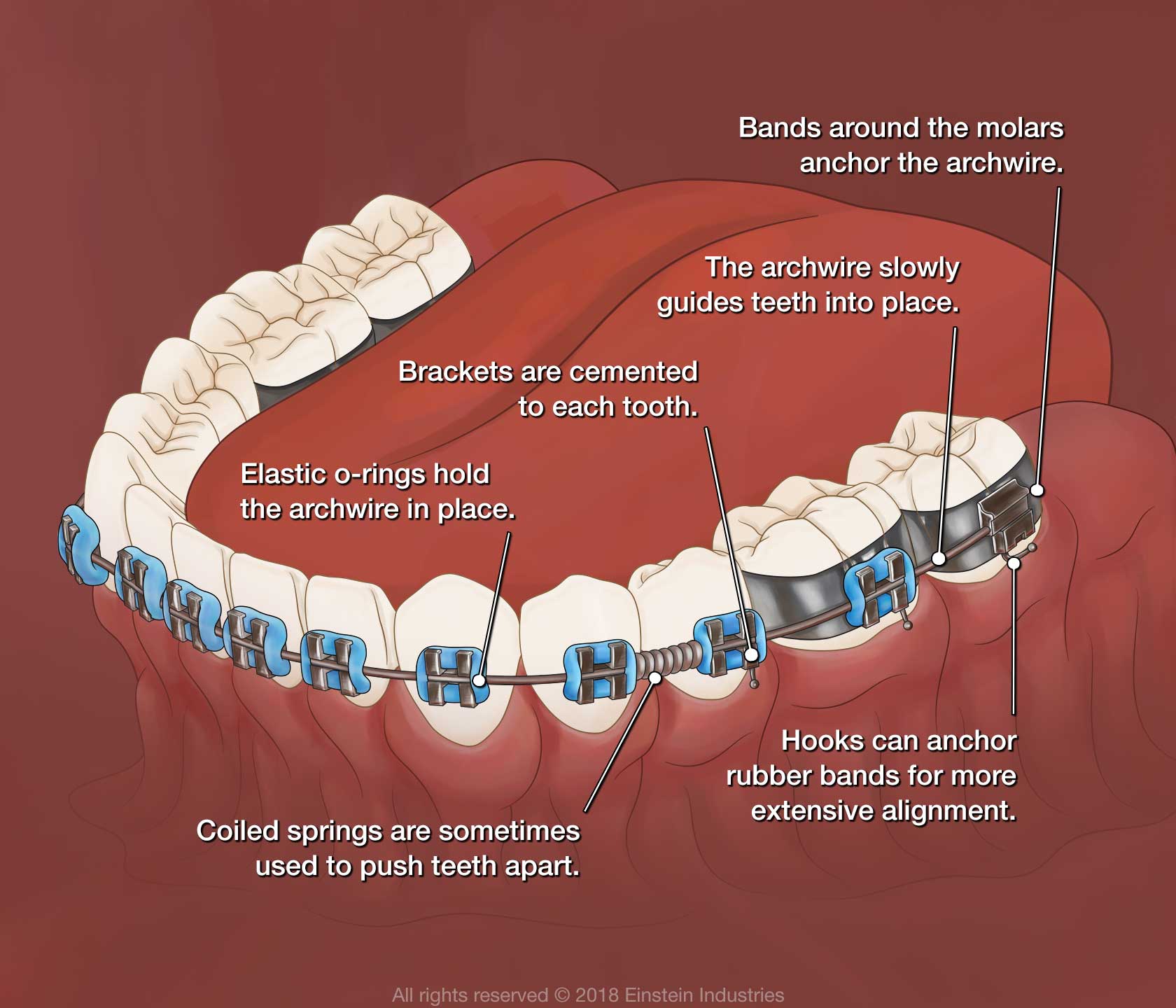
Crooked Teeth Can Affect
YOUR QUALITY OF LIFE
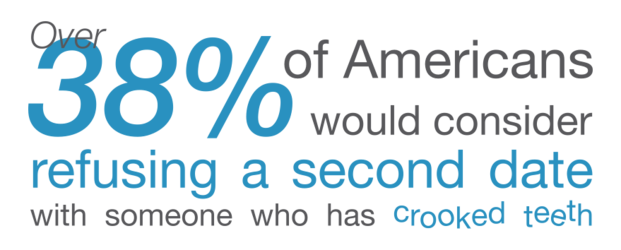
According to a study conducted by Kelton Research, LLC
So how do you know if you need braces?
A Doctor Can Examine
YOUR CASE AND RECOMMEND TREATMENT
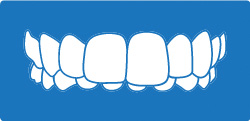
Overbite
The upper jaw protrudes farther forward than the lower jaw.
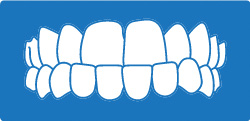
Underbite
The lower teeth protrude past the upper teeth.
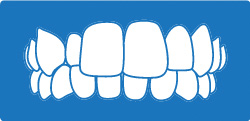
Crossbite
The upper and lower jaws do not meet properly.

Open bite
Space remains between the upper and lower teeth when the jaws meet.
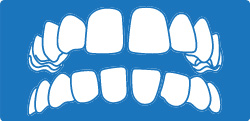
Gapped teeth
Teeth are spaced too widely apart.

Crowded teeth
Teeth are too close and, in some cases, overlap.
But What about Invisalign®?
Many patients have heard about the wonders of Invisalign’s clear aligner system. While Invisalign is a viable option for some, it may not be the best choice to treat more complex cases. However, for patients concerned about metal braces, there are still a variety of aesthetic options available, including clear braces and tooth-colored ceramic brackets.

What Happens during an Exam?
Consultation
During your first appointment, your orthodontist will examine your smile and create a personalized treatment plan.
Bonding Appointment
During this visit, your orthodontist will bond the brackets to the teeth and place the wire and bands.
Adjustments
Throughout treatment, you will return to your orthodontist’s office periodically to adjust your braces. Treatment with braces usually takes between 18 and 24 months.
Debonding Appointment
Once your treatment is complete, your orthodontist can remove your brackets and take impressions for your retainer.
Long-Term Checkup
Your dentist will likely recommend scheduling an appointment about 18 months after your treatment ends to make certain that your teeth are remaining in their proper positions.
Take a closer look at how braces straighten your smile:
Experience a Healthier Smile
THAT ALSO LOOKS GREAT
It can take some time to get used to the sensation of being braces-free. Any inflammation, soreness, or sensitivity typically lasts only a few days. In addition to having a straighter smile, you can expect brushing and flossing your teeth to be much easier. Many patients also choose to enhance their results with teeth whitening or other cosmetic dentistry treatments. Make a good first impression every time with a straighter smile…

How to Best Maintain
YOUR NEWLY STRAIGHTENED SMILE
Your orthodontic treatment is not over when your braces come off. Following removal, your dentist will provide a custom retainer to help keep your teeth in alignment. You should wear this on a nightly basis or as prescribed by your dentist. This is the best way to prevent your teeth from moving out of place and avoid needing re-treatment in the future.
You should also attend biannual visits with your dentist so he or she can monitor your smile. Impacted wisdom teeth and other issues can cause misalignment, so it is important for your dentist to address any possible complications before they start to affect your smile.
To keep your smile feeling and looking healthy after your braces are removed, you should also practice good oral hygiene at home. Brush twice and floss at least once every day. This all sounds great.
But can I afford treatment?
The Cost
OF BRACES
Braces cost between $3,000 and $10,000, depending on the extent of treatment and the type of materials used. The degree of correction needed, the experience of the orthodontist you choose, and even the area in which you live will also play a part in the overall cost of treatment. With a range of options available, your orthodontist can recommend the best type of braces for your needs, as well as a payment or financing plan to help you cover the price of your care.
But can I afford treatment?
Your Choice of Braces
LARGELY DETERMINES COST
Today, there are several alternatives to traditional metal braces, including ceramic tooth-colored braces and clear aligners. Each option comes with its own cost.
Metal Braces
Traditional braces typically cost about $5,000 without insurance coverage. Minor cases of misalignment will generally cost less than more severe jaw-related issues.
Ceramic Braces
Tooth-colored ceramic braces are a popular choice for patients who are looking for a more discreet alternative. If you are interested in ceramic braces, you can expect to pay about $500 to $600 more than metal braces cost.
Clear Aligners
Clear aligner systems such as Invisalign are comparable in price to traditional braces. Invisalign is best suited to mild or moderate cases.
Your Treatment Timeline &
THE SEVERITY OF YOUR MISALIGNMENT
Extent of Treatment
More complex cases of misalignment may require more specialized techniques. In addition, a longer treatment timeline will involve more trips to the orthodontist for adjustments.
Orthodontic Retainers
Another important consideration is the additional cost of retainers, which are necessary to maintain the results of orthodontic treatment. There are several types of retainers available, including fixed and removable. A fixed (bonded) retainer can cost between $250 and $500 per arch. Removable retainers vary in price from $150 to $300 per arch.
Choosing an Experienced Orthodontist
As with any medical procedure, it is important to choose a reputable provider. An orthodontist with more experience may charge more for their services, but they may be able to provide a better result.
Geographic Region
The area you live in can impact the overall cost of treatment. In major metropolitan areas, especially those on either coast, costs are often much higher. This is because larger overhead costs translate to a higher price for orthodontic treatment.
Show me how these factors come together...
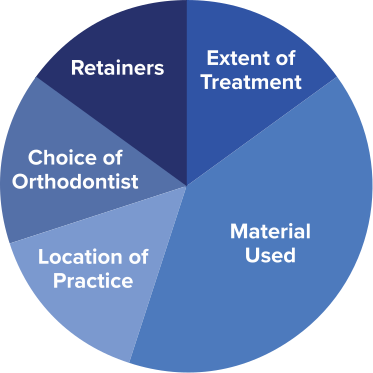
Insurance Coverage & Financing
CAN COVER OUT-OF-POCKET COSTS
In some cases, dental insurance will contribute to the cost of orthodontic treatment if straightening your teeth will provide a medical benefit. However, if you want braces simply to improve the appearance of your smile, your insurance will probably not provide coverage. Insurance is more likely to pay for braces for a child under the age of 18.
Braces can be a significant investment when insurance does not apply. However, financing options and payment plans can help make treatment more affordable. Many doctors accept third-party financing with little or no interest, and others offer in-house plans to cover out-of-pocket costs. Talk to your dentist about your options. It still seems expensive.
Are straighter teeth that important?
An Investment with
Healthier Smile
Straighter teeth are easier to clean, minimizing your risk of gum disease and decay.
Improved Confidence
If you're confident in your smile, it can benefit nearly every aspect of your life.
A Lifetime of Benefits
Simply wear your prescribed retainer to maintain the results for years to come.
Schedule a Consultation
There are many different options available for straightening your smile. Your dentist can recommend the best method. A misaligned bite can cause a range of oral health issues, from decay and gum disease to tooth loss. If you are concerned about the alignment of your teeth, schedule an appointment with your dentist today.
